Our Services – Filtration & Sanitation of Pool Water
 The processes of pool water filtration and sanitation have become integral part of each pool system. Public pools are exposed to relatively large amounts of load due to contaminants that are brought into the water by visitors, and therefore pool water needs to be cleaned and treated on a continuous basis.
The processes of pool water filtration and sanitation have become integral part of each pool system. Public pools are exposed to relatively large amounts of load due to contaminants that are brought into the water by visitors, and therefore pool water needs to be cleaned and treated on a continuous basis.
The cleaning process alone is far from being ideal in terms of cost efficiency, and therefore the pool water must be partly changed and refilled on a regular basis. The amount of refill water is defined in the applicable water sanitation rules.
The first technology step in the pool water treatment process is a surge tank that is used to balance the water displace by swimmers during the pool operation and as water storage space for filter backwashing.
Water spills into the tank over the overflow edges. It is delivered in gravity into the surge tank through overflow gutters and plastic pipes. The surge tank can be made from different materials (concrete tank with waterproofing screed or liner surface finish, polypropylene tank).
As a rule, circulation pumps with hair pre-filters are installed downstream the surge tank. The pumps suck water from the surge tank and deliver it through sand filters back into the pool. That is why the designed pump capacity must be sufficient enough to ensure required delivery capacity despite of pressure losses in the system.
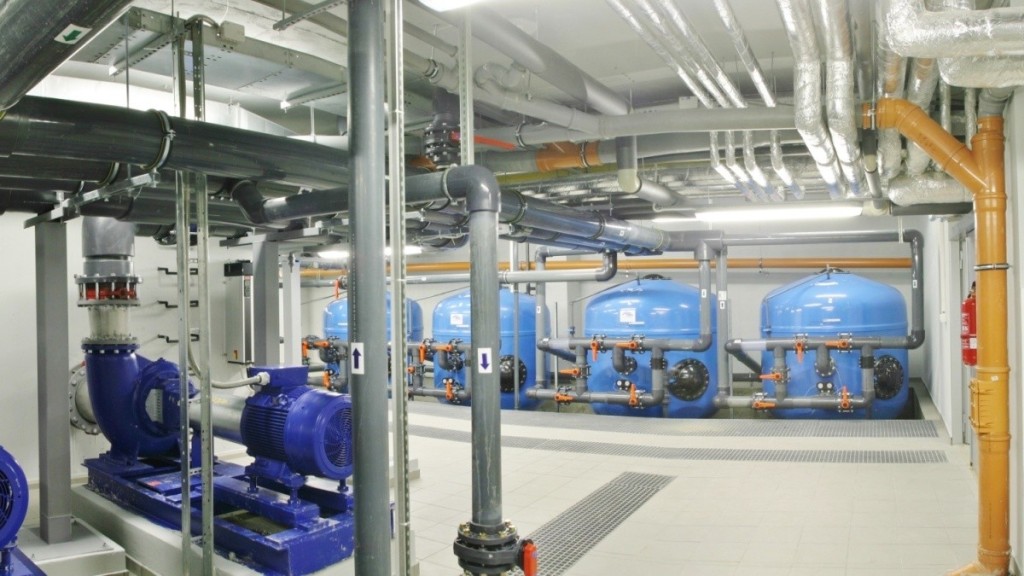 Sand filters are indisputably the biggest component part of the pool technology and play the most important role in the process of elimination of mechanical impurities from the pool water. The GRP sand filters installed by Centroprojekt meet the most demanding criteria for the filtration of pool water.
Sand filters are indisputably the biggest component part of the pool technology and play the most important role in the process of elimination of mechanical impurities from the pool water. The GRP sand filters installed by Centroprojekt meet the most demanding criteria for the filtration of pool water.
The sand bed with a layer thickness of 1 – 1.2m along with different grain size of silica sand, or activated carbon bed, are the best guarantee for high-efficient water filtration process. After passing through the next treatment step, filtered water is delivered via bottom nozzles or bottom distributed pipes back into the pool.
The pool water heating has become integral part of the pool water treatment process. The most widely used heating fluid is water that may be heated up by using several methods. Modern plants use a combination of alternative sources of energy:
The generated heat is transmitted via heat exchangers that are connected to the filtration circuit.
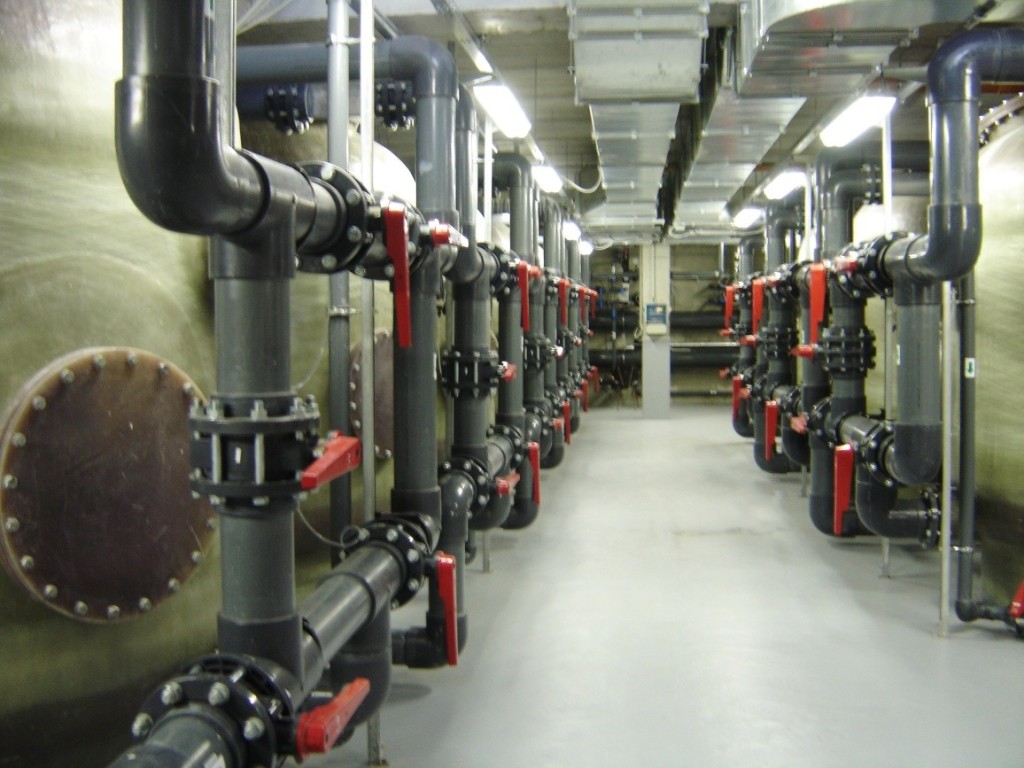 The processes of pool water sanitation and chemical treatment usually represent the last stage in the treatment process. The applicable Czech laws require that chlorine is used as sanitizer for the public pools. The best sanitation results with operating costs being kept low are achieved with liquid chlorine in pressure cylinders.
The processes of pool water sanitation and chemical treatment usually represent the last stage in the treatment process. The applicable Czech laws require that chlorine is used as sanitizer for the public pools. The best sanitation results with operating costs being kept low are achieved with liquid chlorine in pressure cylinders.
The correction of pH value represents another important chemical treatment process. The pH value can be adjusted by adding acids or alkalis into the pool water, using an automated dosing system. The last agent that is used for the pool water treatment is a flocculant that is added into the water delivered to the filters. The flocculant causes that small particles form flocs in the water, which can be then trapped on the filter.
To further improve the pool water quality, CENTROPROJEKT installs additional water sanitation systems. The most common systems include ozonation and UV lamps or a combination of both.
The additional sanitation helps eliminate undesirable effects of chlorine sanitizer such as chlorine smell caused by bound chlorine. The application of such systems has proven to be a perfect tool and despite of higher cost expenditures, it can be recommended for all aquatic facilities.
Treatment of Pool Water
There are three basic methods that can be used for the treatment of the water in your pool. They are often combined to enhance the final effect.
Chlorine
The most common chlorine sanitizers are chlorine tabs, granules or solutions. They act not only onto bacteria, viruses and moulds, but also partly onto algae.
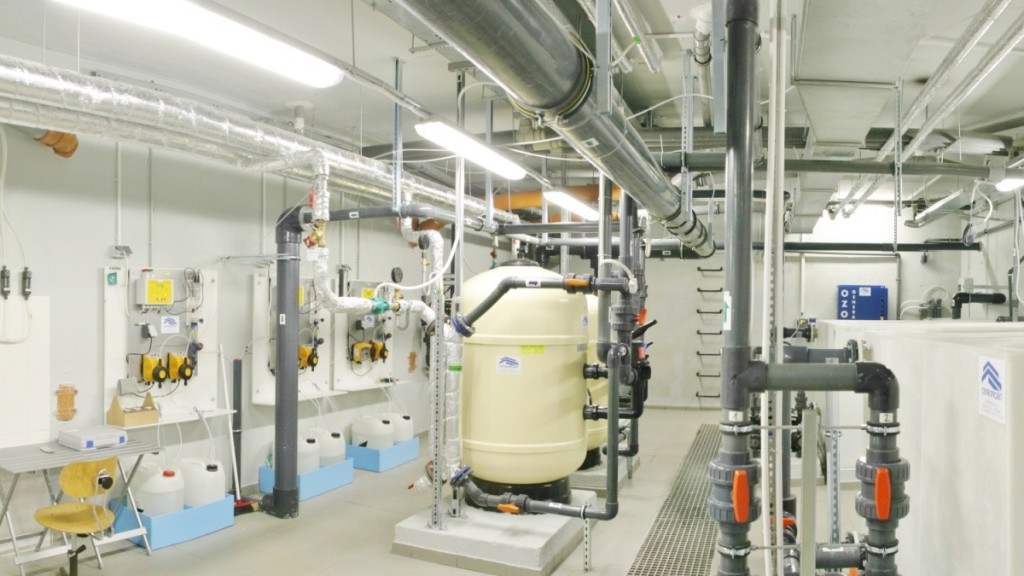 The concentration of chlorine that is used for continuous sanitation should be maintained between 0.3mg/L and 0.5mg/L. Under stabilized operating conditions, Cl concentration should be measured once to twice a week. More frequent measurement is required at peak times and during hot weather. Before measuring the free chlorine concentration, always check and adjust the pH value as needed.
The concentration of chlorine that is used for continuous sanitation should be maintained between 0.3mg/L and 0.5mg/L. Under stabilized operating conditions, Cl concentration should be measured once to twice a week. More frequent measurement is required at peak times and during hot weather. Before measuring the free chlorine concentration, always check and adjust the pH value as needed.
The best chlorination options under stabilized operating conditions are maxi or mini chlorine tabs or combi tabs. The chlorine tabs contain free chlorine at the highest possible concentration, i.e. the Cl content reaches 90%.
The tabs are stable in shape and dissolve very slowly during several days, most commonly during 6 – 8 days. Thus they allow that the chlorine dosing unit or skimmer is refilled only once a week. The required chlorine amount is released by gradual dissolving of the tab.
It is commonly accepted that if the Cl concentration drops below 0.3mg/L, it is absolutely necessary that a new dose of chlorine sanitizer is added. The required level of chlorination varies depending on the pH value, water and air temperature and the number of bathing persons as well as on the frequency and intensity of rainfall and storms.
 The above-mentioned combi tabs combine three effects. They include chlorine for sanitation, anti-algae agent and flocculant for the elimination of dirt particles. You can easily and comfortably achieve a triple effect that you would otherwise achieve by adding successively three different agents.
The above-mentioned combi tabs combine three effects. They include chlorine for sanitation, anti-algae agent and flocculant for the elimination of dirt particles. You can easily and comfortably achieve a triple effect that you would otherwise achieve by adding successively three different agents.
All chlorine agents must be protected against moisture during storage.
OZONE GENERATOR
The ozonation systems are used for:
The ozonation system can be integrated into the pool water treatment system not only for the new-build and renovation projects, but also into the existing technology systems.
Public Pools & Water Parks
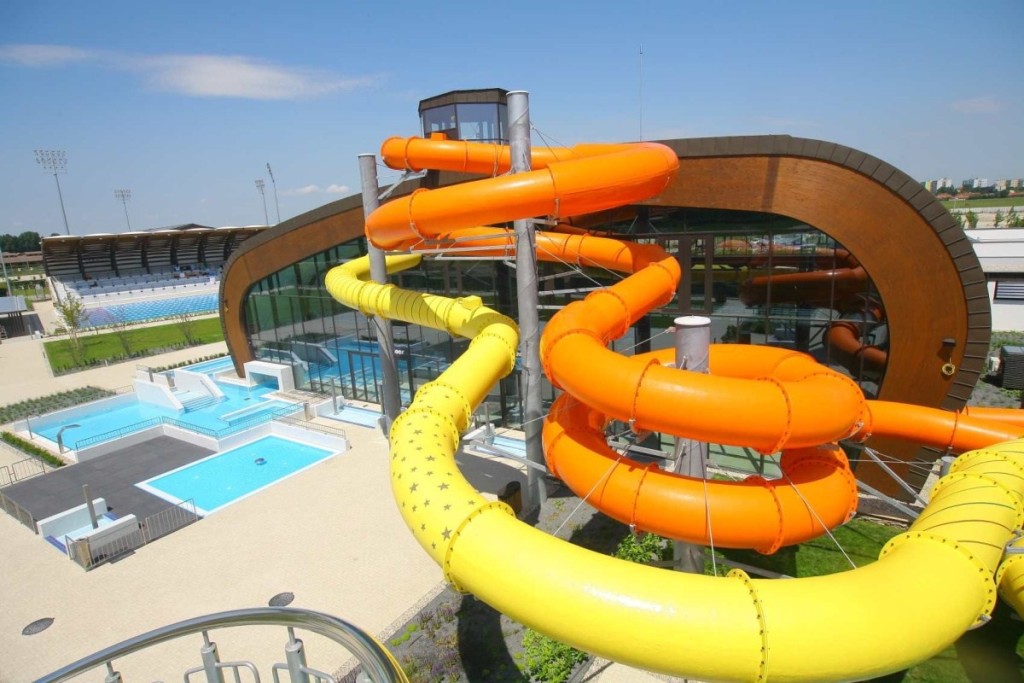 The pool water treatment based on the combination of ozone and chlorine is being increasingly used for the public pools. More stringent requirements for the water quality are the main reasons for this.
The pool water treatment based on the combination of ozone and chlorine is being increasingly used for the public pools. More stringent requirements for the water quality are the main reasons for this.
The ozonation technology allows the user to reduce the amounts of chlorine to be added and hinder the formation of chlorination by-products, and thus helps eliminate typical “pool smell”, hinder the propagation of epidemics and considerably reduce the growth of algae and moulds.
Whirlpools and private pools
The whirlpools and private pools can be FULLY OZONATED so that the water treatment is fully chlorine-free.
Ozone as a high-efficient sanitizer ensures that your pool water remains bacterially safe and crystal-clear.
The added value of bathing in water with low concentration of residual ozone is a positive therapeutic effect (see Ozone Therapy)
Advantages of ozonation:
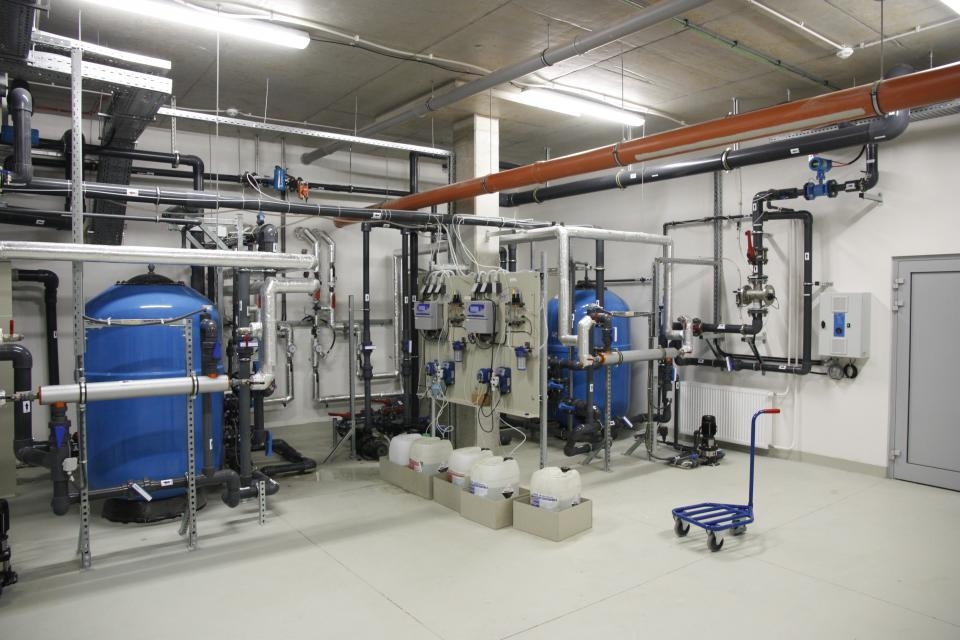
Sufficient generation of ozone during the pool water treatment process is a key factor for proper operation of the system. Based on this parameter, it is necessary to choose appropriate type of ozone generator and ozonation system.
The amount of ozone that must be added for proper pool water treatment cannot be fully defined since it depends on many factors:
It is generally recommended that ozone is added in concentrations of 0.8 – 1.0 mg/L of water at water temperature up to 28°C and 1.0 – 1.2 mg/L of water at water temperature above 28°C. It is necessary to maintain the pH value within the range of 7.0 – 7.4.
The ozonation is used with success for the treatment of water in small natural ponds and bio-pools.
UV LAMPS
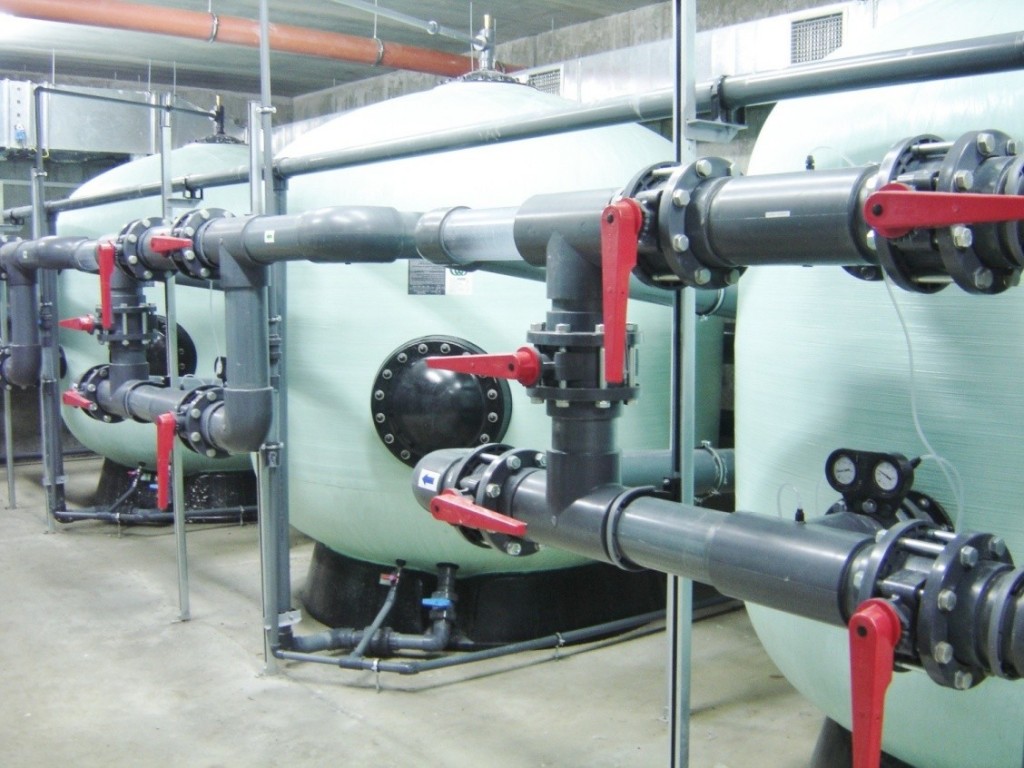 The destruction effect of ultraviolet light on micro-organisms (bacteria, viruses, moulds and algae) has been known for over 100 years. This technology is used today very frequently for the following reasons:
The destruction effect of ultraviolet light on micro-organisms (bacteria, viruses, moulds and algae) has been known for over 100 years. This technology is used today very frequently for the following reasons:
Advantage of UV sanitation against chemical agents:
Delivery and Installation of Pool Water Technology
Every delivery and installation of the pool water technology systems begins with placing orders with the manufacturers or sellers of the equipment, components and materials. CENTROPROJEKT GROUP conducts market research for price analysis every year and carefully checks the quality and references of the manufacturers. These are our key criteria for the selection of suppliers. When selecting a manufacturer of the pool water technology components, we particularly focus on:
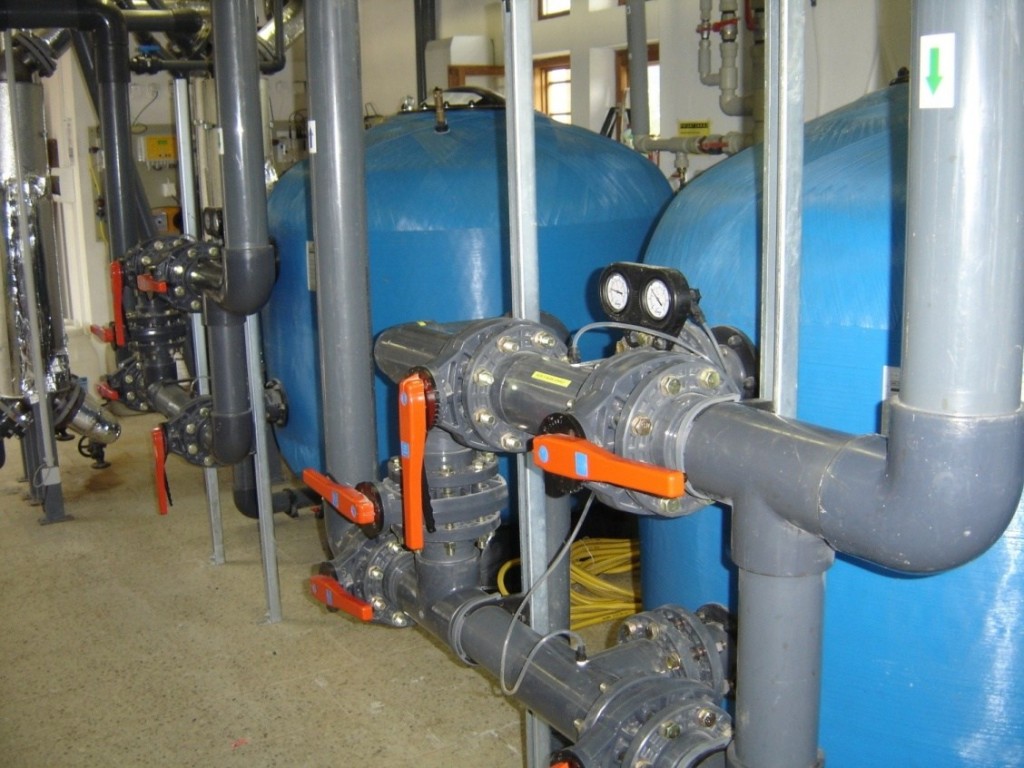 In case of larger technology units, items to be delivered are sent directly to the construction site, while the company´s owned depot in Zlín-Louky is used for the storage of pool water systems and chemicals for smaller projects.
In case of larger technology units, items to be delivered are sent directly to the construction site, while the company´s owned depot in Zlín-Louky is used for the storage of pool water systems and chemicals for smaller projects.
The outdoor installations require careful coordination between the building trades and pool technology installers to avoid potential piping conflicts and damage to pipes. The indoor facilities are even more complex in terms of coordination of the work tasks. Here it is necessary to strictly adhere to the design documents and continually refine the work progress and time coordination between own staff and other trades.
The installation of pool water technology systems is very specific due to its complexity. The predefined workflow steps for the installation of component parts must be strictly followed during the installation.
Ambient air temperature and humidity are limiting factors in most cases.
The glueing of vinyl pipes and the welding of DLW liner require a minimum temperature to complete a waterproof joint. Low temperatures may lead to forced interruption of the running work, and thus cause delay in the opening of the whole complex.
Considering all limiting factors during the installation, a great deal of importance should be attached to a proper work schedule, which also includes occurrence of adverse weather and its impact to work.